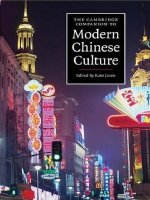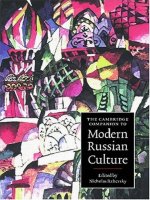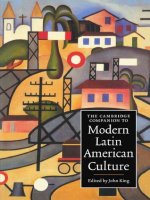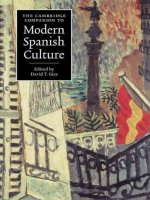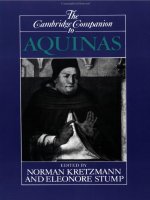the cambridge companion to modern russian culture
Bạn đang xem bản rút gọn của tài liệu. Xem và tải ngay bản đầy đủ của tài liệu tại đây (2.16 MB, 397 trang )
The CambridgeCompanion to
Modern Russian Culture
Russia is a dominant force in theworld, yet its culture hasbeen
shaped by tensions involved inits unique position on themargins
of both East and West. As Russia faces the latest culturalchallenge
from outside its national boundaries, this volume introduces
Russian culture in all its rich diversity, including the historical
conditions that helped shape itand the arts that expressits
highest achievements. Newly commissioned essaysby leading
scholars explorelanguage, religion, geography, ideological
structures, folk ethos and popular culture, literature,music,
theatre, art, and film. Achronology andguides to further reading
are also provided. The Companionprovides both historical
orientation for the central processesof Russian culture and
introductory surveys of the artsin their modern context. Overall,
the volume reveals, forstudents, scholars, and all those interested
in Russia, the dilemmas, strengths, and complexities ofthe
Russian cultural experience.
Nicholas Rzhevsky is Associate Professor of German at the
StateUniversityofNewYork,StonyBrook.Heisauthorof
Russian Literature and Ideology (1983) and editor ofAn Anthology of
Russian Literature: Introduction to a Culture (1996), among other
works. He edited and translated Pushkin’s Boris Godunov and
wrote the English-language version of Crime and Punishment
recently directed by Yury Liubimov at London’s Lyric Theatre,
Hammersmith.Cambridge Companions to Culture
The Cambridge Companion to ModernGerman Culture
Edited by Eva Kolinskyand Wilfried van der Will
The Cambridge Companion to ModernRussian Culture
Edited by Nicholas Rzhevsky
The Cambridge Companion to ModernSpanish Culture
Edited by David T. Gies
Modern Russian Culture
edited by
Nicholas Rzhevsky
published by the press syndicate of the university of cambridge
The PittBuilding, Trumpington Street, Cambridge, United Kingdom
cambridge university press
The Edinburgh Building, Cambridge cb2 2ru,UK
40 West 20thStreet, New York, nvicy 10011–4211, USA
477 Williamstown Road, Port Melbourne, vic 3207, Australia
Ruiz de Alarcon 13, 28014 Madrid, Spain
Dock House, The Waterfront, Cape Town 8001, South Africa
©
Cambridge University Press 1998
This book is in copyright. Subject to statutory exception
and to the provisions of relevant collective licensing agreements,
no reproduction of any part may take place without
the written permission of Cambridge University Press.
First published 1998
Fourth printing 2002
Printed in the United Kingdom at the University Press, Cambridge
Typeset in9
/
13 pt Lexicon (The Enschedé Font Foundry), in QuarkXPress
®
[se]
A cataloguerecord for this bookisavailable from the BritishLibrary
Library ofCongress Cataloguing in Publication data
The Cambridge Companion to modern Russian culture / edited by Nicholas
Rzhevsky.
p. cm. – (Cambridge companions to culture)
Includes bibliographical references and index.
isbn 0 52147218 0 (hardback)
isbn 0 521 47799 9 (paperback)
1. Russian – Civilization.
2. Russia (Federation) – Civilization.
3. Arts, Modern – Russia.
4. Arts, Modern – Russia (Federation)
I. Rzhevsky, Nicholas, 1943–.
II. Series.
dk32.c33 1998 947.08 – dc21 98-3850 cip
isbn 0 52147218 0 hardback
isbn 0 52147799 9 paperback
Ј
Contents
List ofillustrations ix
List ofcontributors xi
Chronology xiv
Note onnames andtransliteration xxviii
1 Russian cultural history:introduction 1
nicholas rzhevsky
Part I Cultural identity
Origins
2 Language 19
dean s. worth
3 Religion: Russian Orthodoxy 38
dmitry s. likhachev
Boundaries
4 Asia 57
mark bassin
5 The West 85
pierre r. hart
6 Ideological structures 103
abbott gleason
7 Popular culture 125
catriona kelly
Contents
viii
Part II Literature and the arts
8 Literature 161
david m. bethea
9Art205
john e. bowlt
10 Music 236
harlow robinson
11 Theatre 264
laurence senelick
12 Film 299
nikita lary
Suggested reading 330
A selectfilmography 347
Index 355
Illustrations
4.1 Vasily Ivanovich Surikov,“Yermak’s conquest of Siberia in1582”
(1985). Oil on canvas. Bypermission of the State Russian Museum, St.
Petersburg. 63
7.1 Zemstvostatisticians in a Russian village. From HaroldWilliams,
Russiaof the Russians (London, 1914). Taylor Institution,Oxford. 130
7.2 Pilgrims at a Russian monastery.From Rothay Reynolds, MyRussian
Year (London, c. 1912).Taylor Institution, Oxford. 132
7.3 “The four lovingheartswho spend their timeingaming and amuse-
ments.” Late eighteenth-century woodcut.FromIu. Ovsiannikov,The
Lubok (Moscow,1968).Taylor Institution,Oxford. 139
7.4 “The sirin-bird.” OldBelieverwatercolor in the styleof an engraved
lubok. Probably early nineteenthcentury. From Iu.Ovsiannikov,The
Lubok (Moscow,1968).Taylor Institution,Oxford. 140
7.5 Girls using kacheli, a Russian swing, and a seesaw, bothpopular
amusements since medieval times. Russian lithograph, c. 1850,
author’s own collection. 150
7.6 “Tsar Saltan’s feast”: illustration byIvan Bilibin to Pushkin’s verse
folk-tale stylization Skazkao tsareSaltane, Moscow 1905. Author’s own
collection. 154
11.1 Griboedov’s “Woe fromWit” at theMoscowMaly Theatre in the
1850s: L. V.Samarin as Chatsky, Mikhail ShchepkinasFamusov,and
G. S. OlginasSkalozub. Phototype byPanov. LaurenceSenelick collec-
tion. 268
11.2 Korsh’s Theatre, Moscow,designed by the architect M.N. Chicagov.
Laurence Senelick collection. 270
11.3 The lastactof Chekhov’s TheThree Sistersat the Moscow Art Theatre,
directed by Stanislavsky inthe setting by Viktor Simov (1903).
Laurence Senelick collection. 271
11.4 Michael Chekhov asHamlet.Laurence Senelick collection. 279
11.5 A Blue Blouse troupedemonstrating“Fordism inthe factory.”
Laurence Senelick collection. 283
11.6 Act ii ofArmored Train14–69 at the Moscow ArtTheatre (1927).
Laurence Senelick collection. 286
List of illustrations
x
Contributors
mark bassin: Lecturer, University CollegeLondon.Author of Geographical
Imaginations andImperial Power: The Russian Annexation ofthe AmurRiver
1840–1865, essays and articlesonRussian perceptions ofthe East, the
history of geopolitics, and the history ofenvironmentalismin the
Slavic Review, AmericanHistorical Review, Journalof Modern History, and
Transactionsof the Instituteof BritishGeographers. Former fellow inthe
Institute for European History, Kennan Institute,andthe Remarque
Institute.
David M. Bethea: Vilas Professor ofSlavic Languages, University of
Wisconsin–Madison, SeniorAssociate Member, Russian Centre, St.
Anthony’s, Oxford (1994–95),former Director, Middlebury College
Russian School. Author of Khodasevich: HisLifeand Art,TheShape of
Apocalypse inModern Russian Fiction, JosephBrodsky andthe Creation of
Exile, articles and essaysinSlavic Review, PMLA, Slavicand EastEuropean
Journal, Russian Review, CaliforniaSlavicStudies, and the NYTimesBook
Review. Editor ofPushkin Today and Pis’maV.Khodasevicha kN.Berberovoi.
John E. Bowlt: Professor, University of SouthernCalifornia.Director,
Institute of Modern Russian Culture at Blue Lagoon,Author of The
RussianAvant-Garde: Theoryand Criticism1902–34, RussianArt 1875–1975,
The SilverAge: Russian Artof the EarlyTwentieth Century,articles and
essays inForm, ArtJournal, Soviet Studies, Slavonic andEast European
Review, Apollo, ArtNews, Russkaya mysl, Russian Review, Journalof Russian
Studies, MetropolitanMuseumJournal, Performing Arts Journal, Twentieth
Century Studies,CornellReview, Times LiterarySupplement, and NewYork
ReviewofBooks. Editor ofworksin Russian artstudies and co-editor of
RussianFormalism and KazimirMalevich. Curator and consultantfor
numerous exhibitions of Russian art, stage, andcostumedesign.
Abbott Gleason: Professor, Brown University. President, American
Association for the Advancement of Slavic Studies. Author of
Totalitarianism: the InnerHistory oftheCold War, Bolshevik Culture:
Experiment andOrder intheRussianRevolution, Young Russia: the Genesisof
RussianRadicalism inthe 1860s, Europeanand Muscovite: IvanKireevsky and
the Originsof Slavophilism, essays, articles, andreviews in Journalof
Interdisciplinary History, ContemporaryEuropean History, Russian Review,
Slavic Review, AmericanQuarterly, and TheJournal of ModernHistory.
Pierre R. Hart: Professor and Chair, Louisiana StateUniversity. Author
of G.R. Derzhavin:APoet’sProgress, articles,essays, and reviewsinSlavic
and EastEuropean Journal, Canadian–AmericanSlavic Studies, SlavicReview,
RussianLanguage Journal, ModernFiction Studies, ModernLanguage Journal,
The ModernEncyclopedia ofRussian andSoviet Literature, and theHandbook
of Russian Literature.
Catriona Kelly: Reader inRussian and Tutorial Fellow of New College,
University of Oxford. AuthorofPetrushka,theRussianCarnival Puppet
Theatre, AHistoryof Russian Women’sWriting, 1820–1992,articlesin
numerous collections of essaysandprofessional journals. Editor of An
Anthology ofRussian Women’sWriting, 1777–1992, andco-editor of
Discontinuous Discoursesin ModernRussian Literature,An Introduction to
RussianCulture Studies, and ConstructingRussian Culturein theAge of
Revolution.
Nikita Lary: Professor, York University, Toronto. AuthorofDostoevsky
and SovietFilm: Visions ofDemonic Realism, Dostoevskyand Dickens, essays,
articles, andreviewsin SlavicandEast EuropeanJournal, Sightand Sound,
Slavic Review, Slavicand East EuropeanArts, Kinovedcheskie zapiski,
Eisenstein Rediscovered, Echoes ofGlasnost’ inSoviet Ukraine, EisensteinNo.2,
Chas-Pik, Rossiia, Epicene, ThePenguinCompanion to Literature:Britain and
Commonwealth, HistoricalJournalof Film,Radio andTelevision, Victorian
Studies,Dostoevsky Studies
, Globe,
and Mail.
Dmitry S. Likhachev: Academician, Institute of World Literature,
Russian Academy ofSciences, St. Petersburg. Former head Soviet
Culture Foundation and Deputy, Congress of Russian Deputies.
Author and editor ofnumerousworks on Russian literature and
language. Widely regarded as theprimarymodern authority and
conscience of Russian culture. Advisor onculturalmatters to the
Soviet and Russian Federation governments.
Harlow Robinson: Professor and Chair,NortheasternUniversity.
Author of TheLast Impresario: theLife, Times, andLegacy of SolHurok, Sergei
Prokofiev: aBiography, articles, essays, andreviewsin Musical Quarterly,
Opera News,OperaQuarterly, DanceQuarterly, DanceMagazine, Russian
Review, SlavicReview, Slavicand East EuropeanJournal, andtheNew York
TimesBook Review. Radio and televisioncommentatoron Russian
music and culture. EditorofThe Operas ofSergei Prokofievand their
List of contributors
xii
RussianLiterary Sources, musical compositions, and SelectedLetters of
Sergei Prokofiev.
Nicholas Rzhevsky: State UniversityofNew York, Stony Brook.
Author of Russian Literature andIdeology, articles andessaysin Encounter,
Nation, ModernDrama, RussianReview, SlavicReview, NewLiterary History,
and (with Yury Liubimov) an English-languageadaptation of Crime
and Punishment.Editorof An Anthologyof Russian Literature. Introduction
to aCulture, and co-editor of MediaϾϽMedia, Dramaturgsand
Dramaturgy, and Slavicand East EuropeanArts.
Laurence Senelick: Fletcher Professorof Drama and Oratory atTufts
University, Honorary Curator of Russian Drama and Theatreat the
Harvard Theatre Collection. Recipientofthe St. George medalofthe
Ministry of Culture oftheRussian Federation. His many books
include TheChekhovTheatre: ACentury ofHisPlays inPerformance, Serf
Theatre: TheLife andArtof MikhailShchepkin, AntonChekhov, National
Theatre inNorthern andEasternEurope, 1749–1900:A Documentary History,
and GordonCraig’sMoscow Hamlet. He haseditedand translated Russian
Dramatic Theoryfrom Pushkintothe Symbolists, CabaretPerformance:Europe
1890–1940, Russian Satiric Comedy, RussianComedy of theNikolaian Era. His
dramatic adaptation of DeadSouls was staged in Boston.
Dean S. Worth: Professor, University ofCalifornia,Los Angeles. Past
Chair, American CommitteeofSlavists, member Academic Councilof
the Kennan Institute forAdvanced Russian Studies. President,
Western Slavic AssociationandVice President, International
Committee of Slavists. Author of fifty-plus publications on Russian
culture and approximately 160onlinguistics, Paleosiberian
languages, andRussian folk poetics.
List of contributors
xiii
Chronology
Literature
Ninth century
c. 863Saints Cyril, Methodius, Glagoliticalphabet
2nd halfninth century Greek Teacher’s Gospel
Late ninthcentury first trans. Bible
Tenth century
988 trans. Bible, liturgicaltexts, saints’ lives
Eleventh century
c. 1017beg. NovgorodFirst Chronicle
1036 SermonofLuka Zhidyata
c. 1040first chroniclesKievan Rus’
c. 1050Hilarion’s SermononLaw andGrace
Chronology
Performing Arts, Art, Architecture
Tenth century
c. tenthcentury Churchof Ilia, Kiev
991–96 AssumptionChurch (Tithe); Kiev
Eleventh century
1036 Transfiguration Cathedral, Chernigov
1036–41 St.Sophia, Kiev
1045–50 St.Sophia, Novgorod
1046–67 St.Sophia Russo-Byzantine mosaics
Chronology
History
Third to eighthcenturies
Tribal migrations
Ninth century
c. 750–800Vikings reach central Volga
c. 862–879Slavs inviteRiurik, Sineus, Truvor
Beg. reignKiev Great Princes
882 Olegunites Kiev, Novgorod
Tenth century
907 Olegattacks Constantinople
c. 955Olga baptized Christian faith
c. 962beg. reign Sviatoslav
c. 968Sviatoslav defeats Bulgarians
969 Kievbesieged by Pechenegs
978 Beg.reign Vladimir
988 Vladimiraccepts Byzantine Christianity
Eleventh century
1016 SaintsBoris and Gleb d.
1019–54 ReignYaroslav (“theWise”)
1037 Victory over Pechenegs
1051 Hilarion,first Metropolitan Russian origin
1051–54 Russian Pravda
1056–57 Gospelof Ostromir
1079–85 Borisand Gleb
c. 1088Nestor’s LifeofTheodosius
1089 Ioann’s Church Regulation
c. 1093–95Primary Compilation, PrimaryChronicle
1095 NovgorodMonthlyReadings
Twelfth century
1096–1117 InstructionsofVladimir Monomakh
c. 1110–13Nestor’s PrimaryChronicle(TaleofBygone
Years)
c. 1117Silvester’s secondredaction PrimaryChronicle
1128–57 Synodalcopy NovgorodFirst Chronicle
c. 1187TaleofIgor’s Campaign
1070–88 Archangel Michael Cathedral,Vydubetsky
Monastery, Kiev
1073–78 Monasteryof CavesRusso-Byzantine
mosaics
1089–90 Church St.Michael, Pereyaslavl
c. eleventhcentury znamennyraspev (choral singing)
c. eleventhto twelfth centuries kriukovyenoty
(musical notation)
Twelfth century
c. firsthalf twelfth century Vladimir Mother of God
icon
1103 AnnunciationChurch, Novgorod
1114 MonkAlipy d.
1115–23 CathedralSaints Boris and Gleb,Chernigov
1117–19 CathedralNativity of Virgin, Antoniev
Monastery
1119–20 CathedralSt. George, Yuriev Monastery
1128 SpasskyMonastery, Polotsk
1135–44 Church Dormition,Kanevo
1140 KirillovskyMonastery beg. near Kiev
1145 Church Borisand Gleb, Smolensk
c. 1150Church Boris and Gleb, Kideksh
1152 Church ofSavior, Pereiaslavl-Zalessk
c. 1152St. Olaf’sChurch, Novgorod
c. 1158Uspensky Cathedral, Vladimir
1165 Church Intercessionof Virgin onNerli
1179 Church Annunciation,Miachino
1185–92 Church SaintsPeter and Paul, SinichiaHill
1190–92 Church St.Basil, Ovruch
1194–97 CathedralSt. Dmitry, Vladimir
1198 Church ofSavior, Novgorod
1061 Kievtroops defeat Polovtsy (Kumans)
1074 St.Theodosius d. (founder Kiev-Pechersky
Monastery)
1078–93 ReignVsevolod
1093–1113 ReignSviatopolk, Iziaslav’s son
1096 Polovtsy occupy Kiev
Twelfth century
1113–25 ReignVladimir Monomakh
1136 Novgorodbreaks away from Kiev
1154–57 Kievreign Yury Dolgoruky, founder
Moscow
1169 AndreiBogoliubsky, Prince of Vladimir, sacks
Kiev
1170 Novgorodforces defeat Suzdal
1174–1212 Vsevolod (“Big Nest”) Great Prince of
Vladimir
1185 Igor’s unsuccessfulcampaign against Polovtsy
xv Chronology
Thirteenth century
c. latetwelfth-early thirteenth century Supplication of
Daniil theExile
c. 1223–before1246 Tale of Ruin RussianLand
1237–40 Tale ofBattle onRiver Kalka
c. 1239TaleofBatu’s invasion
mid. thirteenthcentury trans. Greek Aleksandriia
1263 LifeofAleksandr Nevsky
Fourteenthcentury
1340s Tale ofBattle Novgorodwith Suzdal
1377 LaurentianChronicle
c. 1393Zadonshchina(Beyond the Don)
1396 d.Stefan of Perm
Fifteenth century
c. 1400TaleofBattle with Mamai
Thirteenth century
1202–06 Birthof Mother of God Monastery, Vladimir
1216–24 CathedralTransfiguration of Savior,
Yaroslavl
1222–25 CathedralsNativity of Virgin, St. George,
Vladimir-Suzdal
1292 Church St.Nicholas onLipna, Novgorod
Fourteenthcentury
1326 UspenskyCathedral, Moscow Kremlin
1330 Church Saviorin Forest, Moscow Kremlin
1333 Archangel Cathedral,Moscow Kremlin
c. 1335Sergius of Radonezh’s Trinity-Sergius
Monastery
c. 1350Icon Savior of Fiery Eye; Assumption
Cathedral, Moscow
1361 Church St.Theodore Stratilates, Novgorod
1367 Kremlinstone walls, Moscow
1370–80 AssumptionChurch, Volotovo Field,
Novgorod
1374 Church Savioron Elijah Street,Novgorod
1378 Theophanes’icons and frescoes, Church
Transfiguration, Novgorod
1379 Church Nativityof Virgin, Mikhailitsa
1383–84 Church St.John the Divine, Radokovitsi,
Vitka river
Fifteenth century
c. 1400Uspensky Cathedral, Zvenigorod
Thirteenth century
1223 Mongolsvictory, Kalka River
1237–40 Mongolinvasion. Cities devastated
1240 Kievtaken; beg. Mongol “Yoke”
Aleksandr Nevskydefeats Swedes, NevaRiver
1242 AleksandrNevsky’s “Battle on the Ice”
1252–63 ReignAleksandr Nevsky
1263–72 Yaroslav reign in Vladimir
1270 Novgorodtreaty Hanseatic League
Fourteenthcentury
1317–22 ReignYury of Moscow
1326 MetropolitanPeter moves see to Moscow
1328–40 IvanI (“Kalita”)
1359–89 ReignMoscow Prince Dmitry (“of the Don”)
1380 Dmitrydefeats Mongols, Kulikovo Field
1389–1425 Vasily I reign Moscow
1389–95 Tamerlane attacksGolden Horde
Fifteenth century
1425–62 Vasily II (“The Dark”)
History Literature Performing Arts, Art, Architecture
xvii Chronology
1406 ArsenianEdition saints’ lives
c.1420Hypatian Chronicle; Epiphanius the Wised.
1433 b. Nil Sorsky
1442 Pachomius Logothetes’ Russian Chronograph
c. 1474d. Afanasy Nikitin author, Journeybeyond Three
Seas
c. 1475–1556Maksim Grek
Sixteenth century
c. 1540sMacarius’ Chet’i Minei
1547 Sylvestr’sDomostroy
1550 Peresvetov’sTaleofSultan Mahmed
1551 Stoglav
1560–63 Athanasius’Book of Generations
1564 Fedorov, Mstislavets’Apostol printed
1568 Psalter printed
1560s–70s CorrespondenceIvan IVand Kurbsky
1581 OstrogBible
1405 Rublev, Theophanes, Prokhor icons Nativity,
Baptism, Transfiguration
1406 Church SaintsPeter and Paul Kozhevniki,
Novgorod
c. 1408Rublev andDaniel theBlack’s Christ inMajesty
c. 1410–22Rublev’s Old Testament Trinity
1413 Church St.Basil on Hillock, Pskov
1420 Rublev interior Cathedral,Trinity-Sergius
Monastery
1421–22 Church St.John the Compassionate, Lake
Miachino
c. 1430Rublev, d.
1441 firstmention demestvennyiform singing
1450 Icon“Battle SuzdalandNovgorod”
1479 Fioravanti’s Assumption Cathedral, Moscow
Kremlin
1484–89 AnnunciationChurch rebuilt,Moscow
Kremlin
1484–90 IvanIII’s Novgorod citadel
1485–1516 MoscowKremlin reconstruction
1487–91 ArmouryChambers, Moscow Kremlin
Sixteenth century
1500–02 Dionisiusand sons’ frescoes, Ferapont
Monastery
1505 Novy’s Archangel Michael Cathedral
1510–14 CathedralIntercession Mother of God,
Suzdal
1515 Transfiguration Cathedral, KhutynMonastery
1524–25 CathedralSmolensk Mother of God;
Novodevichy Convent
1529 Church St.Prokopy
1530–32 Vasily III’s Trinity Cathedral, Trinity-
Danilov Monastery
1532 AscensionChurch, Kolomenskoe
1439 Councilof Florence
1448 Russian Church autocephalous
1453 Fall of Constantinople
1462–05 Ivan III (“the Great”)
1470 “Judaizers”heresy, Novgorod
1472 Ivanm. Sophia Paleologue
1472–85 Moscowrules Perm, Rostov, Novgorod,
Tver
1497 Codeof Ivan III (Sudebnik)
Sixteenth century
1503 Church council;“Possessors” – “Non-
Possessors”debate
1505–33 ReignVasily III
1533–38 regencyElena Glinskaya
1533–84 ReignIvan IV(“the Terrible”)
1550–51 HundredChapters Council (Stoglav)
1552 Kazantaken
1555 EnglishMoscow Trade Company
1558–83 LivonianWar
1565 Ivan introduces Oprichnina
1569 MetropolitanPhilip strangled
1571 CrimeanTartarsraid Moscow
Seventeenth century
1600 ChudovskyChet’i Minei
1614 MoscowPrinting House founded
1653 Nikonreforms, Nomokanon
1669–76 Avvakum’s Life
1677–78 Polotsky’sMany-Flowered Garden
1680 Polotsky’s RhymedPsalter, Rifmologion
late seventeenthcentury Misery-Luckless-Plight;
Shemyaka’s Judgement,Frol Skobeev, Savva Grudtsyn
1535–37 Church St.Nicholas rebuilt,Pskov
1536 Church SaintsBoris and Gleb, Plotniki
1547 Church DecapitationJohn the Baptist, Moscow
c. 1548Morality plays, Novgorod
c. 1553–1600Cathedral Virgin of Intercessionon
Moat (St.Basil’s the Blessed), Red Square,
Moscow
1557 Trinity Church, Holy Ghost Monastery,
Novgorod
1559–85 DormitionCathedral, Trinity-Sergius
Monastery
1571 Skomorokhimentioned NovgorodChronicles
1589 CodeTsar Fedor Ivanovich, regulation skomorokhi
c. 1598Trinity Church, Moscow
Seventeenth century
1613 Performance chambers, Moscowcourt
1615 Kievreligious puppet shows
1628 DormitionChurch, Uglich
1634–35 IntercessionChurch, Moscow
1635–36 Kremlin“terem” palace
1635–37 Church SaintsZosima and Savvatii, Zagorsk
1643 HolyTrinity Church, Nikitinki, Moscow
1647–50 Church ProphetElijah, Yaroslavl
1648 Tsar Aleksei forbidsskomorokhi
1649–52 Church Nativityof Virgin, Putinki,Moscow
1649–54 Church IoanZlatoust, Korovniki, Yaroslavl
1658 Vasily Likhachevon Italian theatre
1672 Pastor Gregory stages adaptation Bookof
Esther
1673 BalletOrpheus andEurydice; Tsar Aleksei funds
theatre
1582 Yermak conquersKhanate Siberia
1584–98 ReignFedor I,Boris Gudunov regent
1589 FirstPatriarchIov
1591 Ivan’s sonDmitry d. Uglich
1592–97 Restrictionson peasant mobility
1598 Fedor d.; end House of Riurik
1598–1605 ReignBoris Gudunov
Seventeenth century
1601–03 Drought,famine, plague
1604 FirstFalseDmitry invadesRussia
1605 BorisGudunov d.; beg. “Time of Trouble”
1605 ReignFedorGudunov; killedsame year
1605–06 ReignFalseDmitry
1606–10 ReignVasilyShuisky
1607–10 False Dmitry II
1610 Polish forces occupy Moscow
1610–13 Vladislav of Poland, tsar elect
1611 Swedesoccupy Novgorod
1611–12 Armedresistance, Minin and Pozharsky
1613 Beg.Romanov Dynasty, Landed Assembly
chooses Mikhail
1613–45 ReignMikhail
1619–33 Filaret(Mikhail’s father) Patriarch
1632 KievAcademy
History Literature Performing Arts, Art, Architecture
Eighteenth century
1703 firstRussian newspaper Vedomosti (News)
1710 new“civil” alphabet
1711–27 fiveprinting presses open St. Petersburg
1735 Trediakovsky’sNew andBrief Methodfor
Composing Russian Verses
1743 Lomonosov’s Ode on Conquestof Khotina
1676 Tsar Fedor evictstheatre from court
1678 Ushakov’s Saviour Not Doneby Hands
1678–83 Potekhin’s Trinity Church, Ostankino,
Moscow
1679–82 Church St.Nicholas, Kamovniki, Moscow
1684–93 EpiphanyChurch, Yaroslavl
1687–95 Church Resurrectionin Kadashi, Moscow
1690–1704 Church Iconof Sign at Petrovo, Moscow
1695 Church ofAscension, Suzdal
1697–1703 NativityChurch, Bell Tower, Nizhny-
Novgorod
1698–1704 Church St.Anne, Uzkoe, Moscow
Eighteenth century
1701–7 Church Archangel Gabriel(Menshikov
Tower)
1702 Kunst’stheatre troupe arrives
1703 Peter and Paul Fortress
1705 Peter I decree on comedies;Prokopovich’s
Vladimir
1632–34 War withPoland
1637 DonCossacks seizeAzov
1645–76 ReignAleksei
1647 Russian-Polishalliance against Turks
1648 Ukrainianliberation war, Boghdan
Khmelnitsky
1649 Ulozhenie,code of laws
1652 NikonPatriarch
1654 Beg.Schism (Raskol); Old Believers
1654 UkrainianRada allegiance to Russiantsar
1654–57 Russo–PolishWar
1659 Pan-Slavist Yury Krizhanich inMoscow
1661–72 FirstRussian expeditions Kamchatka
1664 S. Polotsky’sLatin school(Moscow)
1665 Mailservice established
1666–67 Church councildeposes Nikon
1669–71 StenkaRazin rebellion
1676–82 ReignFedor III, regent Prince Vasily
Golitsin
1682–1725 ReignPeter I “the Great” (initially with
brother Ivan)
1687 Greek-Latin-Slavonic Academy (Moscow)
1695 War withTurkey/Crimean Tartars
1696 Navalfleet; Turkssurrender Azov
1697–98 Peter travels West
1698 Streltsyrevolt
1699 Trading companies formed;Julian calendar
Eighteenth century
1700 Beg. Northern War with Sweden
1701–03 Foundation St. Petersburg
1705 Militarydraft instituted
1708 Administrativereforms; provinces created
1709 Battleof Poltava
1710 War withTurkey
xix Chronology
1747 Sumarkov’s Khorev
1748 Lomonosov’s ShortGuideto Rhetoric
1757 Lomonosov’s Russian Grammar
1763 Voltaire–Catherine II correspondence
1766 Trediakovsky’s Tilemakhida
1769–70 Novikov’s Truten
c. 1770Brigadier
1779–89 MoscowNews
1782 TheMinor; “Felitsa”
1786 CatherineII’s plays
1790 Radishchev’s Journey fromSt.Petersburgto Moscow
1791 MoscowJournal
1792 “Poor Liza”
1797 Karamzinbeg. Lettersof Russian Traveler
1799 Pushkinb.
1711–14 SummerPalace
1712 Imperialcourt moves to St. Petersburg
1712–33 Trezzini’s Saints Peter and Paul Cathedral,
St. Petersburg
1714 Kunstkammer; Church Transfiguration, Kizhi
1714–52 LeBlond,Braunstein, Michetti,Rastrelli’s
Peterhof
1715 AleksandrNevsky Monastery, St. Petersburg
1716 PrincessNatalie stages plays
1716–24 SecondWinter Palace
1720 Peter I hires Prague actors
1722–26 SaintsPeter and Paul Cathedral,Kazan
1722–41 Twelve Colleges, Vasilevsky Island,St.
Petersburg
1724 Bidlowplay, Moscow
c. 1727Leshchinsky theatre,Siberia
1729 Volkov, actor, b.
1731–34 Church SaintsSimeon and Anna
1733 Dmitrevsky. b.
1734 Winter PalaceTheatre, St. Petersburg
1732–38 Admiralty, St. Petersburg
1735–39 Korobov’sChurch, St.Panteleimon
1738 Danceschool, St.Petersburg
1741–43 Rastrelli’sSummer Palace
1741–50 Rastrelli,Zemtsov’s Anichkov Palace
1743 MusicalRose withoutThorns, St. Petersburgcourt
1748–64 ResurrectionCathedral, Rastrelli’s Smolny
Convent
1749 Nobleman’s Corps’production Khorev
1750 Elizabethencourages Russian actors;Yaroslav
troupe’s AboutPenance ofSinful Man
1711 Senatereplaces boyarduma
1712 St.Petersburg new capital
1713 ConquestFinland
1718 Poll tax; judicial reform
1721 Treaty Nystad. Peter Emperor. Patriarchate
abolished
1722 War withPersia; Table of Ranks instituted
1723 Treaty gives Russia CaspianSea’s southern
shores
1725 Academyof Sciences opens; First Kamchatka
expedition
1725–27 ReignCatherine I
1727 Treaty with China;Bering discovers strait
1727–30 ReignPeter II
1730–40 ReignAnna I
1735–40 War withTurkey
1739 Tatishchev proposesUrals Europe–Asia divide
1740–41 ReignIvan VI
1741–61 ReignElizabeth I
1744 Russia joins Warsaw pact
1755 MoscowUniversity founded
1757 Treaty with France,Austria; Russiainvades
Prussia
1759 Russian forces occupyBerlin
1761–62 ReignPeter III
1762–96 ReignCatherine II (“the Great”)
1764 Governmenttakes church landsand peasants;
women’s education Smolny Convent
1767 Catherine’s Legislative Commission
1768–74 War withTurkey
1772 Firstpartition Poland
History Literature Performing Arts, Art, Architecture
Nineteenth century
1802–03 HeraldofEurope; A.N.Radishchev’ssuicide
1803 Karamzin’s MarfaPosadnitsa; Discourseon Oldand
New Stylein Russian Language
1808 Zhukovsky’s Lyudmila
1809 Krylov’s Fables
1811–16 Collegiumof Amateurs of RussianWord
1815 “Arzamas” literary circle
1816 Karamzin’s Historyof Russian State (completed
1829)
1752 Volkov’s Yaroslav performances; formal actors’
training
1754–62 Rastrelli’sWinter Palace
1756 OperaTaniusha
1757 Academyof Arts, St.Petersburg
1762 Actorsgiven noble rank
1763 Volkov d.
1768–82 Falconet’s Bronze Horseman
1768–85 Rinaldi’sMarble Palace, St.Petersburg
1772 M.Popov’s Anyuta; Synodal Typography prints
znamennyi chants
1773 D. Levitsky’s women’s portraits
1774 JournalMusical Entertainments
1776 Bolshoi Theatre of Opera and Ballet;
Trutovsky’s collection folk songs
1779 D. Bortniansky, Dir. Imperial Chapel Choir;
Dmitrevsky headdramatic school
1780–1801 Cameron’s architectural ensemble,
Pavlovsk
1782–86 Cameron’s Temple of Friendship, Pavlovsk
1783 BolshoiKamennyi Theatre
1784–86 Bazhenov’s Pashkov House, Moscow
1788 Shchepkin b.
1797 V. L. Borovikovsky’sPortraitof M.I Lopukhina
1799 Kozlovsky’sStatue Suvorov, Field of Mars
Nineteenth century
1800 Mochalov b.
1802 Karatygin b.
1804 Glinkab.
1804–18 Martos’sculpture Minin & Pozharsky, Red
Square
1805 decreeinstituting Imperial Theatres
1806–23 Zacharov’s Admiralty, St. Petersburg
1808 SmolnyInstitute; Didelot’s Zephyr andFlora;
Drama News
1773 Diderotvisits Russia
1773–75 Pugachev rebellion
1783 Crimeaannexed. Dashkova heads Academy
1784 Alaskasettled
1785 Charterof Nobility
1787 War withOttoman Empire
1788 Swedendeclares war
1794 Kosciusko rebellion
1796–1801 ReignPaul I
1796 Prussianmilitary reforms
Nineteenth century
1801–25 ReignAlexander I
1802 Creationgovernment ministries
1804–06 ExpansionCaucasus
1805–06 V. Kruzenshtern’s expedition
1806–12 War withTurkey
1807 Battle Friedland; Treaty Tilsit
1808 A.Arakcheev DefenseMinister
1808–09 War withSweden, annexation Finland
1810 Lyceum Tsarskoe Selo,founded
xxi Chronology
1817 Batyushkov’s Dying Tasso
1818 Fatherland Annals
1819 Societyof Lovers of RussianLetters
1820 Ruslan and Liudmila
1821 Pushkin’s Prisonerof Caucasus; Dostoevsky b.
1823 Societyof Wisdom; PolarStar
1824 Mnemozyne;Woefrom Wit
1825 MoscowTelegraph; Boris Godunov
1827 MoscowHerald
1828 Tolstoy b.
1829 Yury Miloslavskyor Russians in1812
1830 BelkinTales,Little Tragedies
1831 EveningsonFarmnear Dikanka; Telescope
1833 EugeneOnegin, BronzeHorseman, “Queen of
Spades”
1834 Belinsky’s LiteraryReveries
1835 Arabesques, Mirgorod; Masquerade
1836 Captain’s Daughter,Contemporary; Inspector
General, “Nose”
1837 Pushkind.; Lermontov’s “Deathof Poet”;
Chaadaev’s Apology ofMadman
1839 Fatherland Notes
1840 HeroofOur Time, Mtsyri; Aksakov’s Family
Chronicle
1841 Lermontovd.
1842 DeadSouls, “Overcoat,” Marriage,
1844 Russian Nights
1846 Poor Folk,Double; Herzen’sWhoistoBlame?
1847 Gogol’sSelected Passages; Goncharov’s Common
Story
1850 DiaryofSuperfluous Man, Month in theCountry;
From theOther Shore
1810 Stock Exchange Building, St. Petersburg
1811 Voronikhin completes Kazan Cathedral
1812 FirstRussian vaudeville Shakhovskoy’s Cossack
Poet
1818 Sadovsky, b.
1818–58 Montferrand’sSt. Isaac’s Cathedral
1819–29 Rossi’sGeneral Staff Building
1823 V.A. Tropinin’sLace-Maker
1824 MalyTheatre, Moscow becomes state theatre
1827 Kiprensky’s Portrait ofA.S. Pushkin
1828–32 Rossi’sAlexandrinsky Theatre
1829–37 Orlovsky’s sculptureKutuzov and Barclay
de Tolly, St. Petersburg
1830–33 Briullov’s Last Day ofPompei
1832 Briullov’s Horsewoman
1833 Borodinb.
1836 Lifeforthe Czar;Inspector General
1839 Mussorgskyb.
1839–49 Ton’s Bolshoi Kremlin Palace
1840 Tchaikovsky b.
1842 Glinka’s Ruslan and Liudmila
1844 Rimsky-Korsakov b.; Repin b.
1848 Glinka’s Kamarinskaia
1856 Vrubel b.
1857 Ivanov’s Christ
’s Appearanceto thePeople
1858 I.Molchanov’s folk chorus
1860 Levitanb.
1862 St.Petersburg Conservatory; Mighty Group
(kuchka); Mikeshin’s sculpture Millennium of
Russia, Novgorod; Balakirev, Lomakin’s music
school
1863 Stanislavskyb.
1812 Invasion of Napoleon; Battles Borodino,
Smolensk
1812 Fort Ross, California,founded
1813 BattleLeipzig
1814 Russian forcesin Paris
1814–15 Vienna Congress
1815 HolyAlliance signed
1819 St.Petersburg University founded
1819–21 ExplorationAntarctica
1825 Decembristrevolt
1825–55 ReignNicholas I
1826–28 Russian-Persian War
1830–32 M.Speransky Russian Code of Laws
1833 S.Uvarov Minister Public Education
1834 Herzen-Ogarevcircle arrested; Kiev University
founded
1834–59 Shamil’ rebellion Caucasus
1842–51 Railroadtrack St.Petersburg–Moscow
1849 Petrashevsky circle arrested
1854–56 CrimeanWar
1855–81 ReignAlexander II (“the Tsar Liberator”)
1856 N.Lobachevsky d.
1857 Herzen’s andOgarev’s Kolokoljournal begun,
London
1858 Treaty with China;Amur region acquired
1859 ConquestCaucasus
1860–73 Expansionrailways
1861 Emancipationpeasants
1864 Localgovernment (Zemstvos); education,
judicial reforms
1867 Russian trans. Marx’s “Das Kapital”; Alaska
sold
History Literature Performing Arts, Art, Architecture
1852 NotesofHunter; Tolstoy’sChildhood
1854 Tiutchev’s Verses;Ostrovsky’s Poverty’sNo Vice;
Tolstoy’s Boyhood
1855 Sevastopol’sStories; Afanasiev’sRussianFolkTales
1856 Rudin; Saltykov-Schedrin’sProvincial Sketches
1857 Tolstoy’s Youth
1858 AThousandSouls
1859 Oblomov;Nest ofthe Gentry;Storm; Dobroliubov’s
“What is Oblomovism?”
1860 OntheEve
1860–62 Houseofthe Dead; Chekhov b.
1862 Fathers andChildren
1863 WhatistoBeDone? Nekrasov’sWho isHappy in
Russia?
1864 NotesfromUnderground
1865–69 War andPeace
1866 CrimeandPunishment
1868 Idiot; Fatherland Notes.
1869 Goncharov’s Precipice
1871 TheDevils; Ostrovsky’sForest
1872 Leskov’s Cathedral Folk
1873 AnnaKarenina
1876 Dostoevsky’s MeekWoman
1877 Turgenev’s VirginSoil
1878–80 Soloviev’s White Lily
1880 TheGolovlyovs; Brothers Karamazov
1881 Dostoevskyd.
1882 Tolstoy’s Confession
1883 Fet’s EveningFires
1887 ThePower ofDarkness
1888 Chekhov’s “Steppe”
1889 KreutzerSonata
1892 Chekhov’s “Ward No.6”; Merezhkovsky’s
Symbols
1893 Chekhov’s Sakhalin Island
1894 Russian Symbolists
1895 Russian Word
1866 Tchaikovsky’s Symphony No:1; Kandinsky b.;
Moscow Conservatory
1869 Mussorgsky’s Boris Godunov
1872 Diaghilevb.; Scriabin b.; Kramskoy’s Christin
Desert
1873 S.V.Rachmaninov b.; Repin’s Volga Barge-
Haulers; Chaliapinb.
1874 Mussorgsky’s P
aintings froman Exhibition;
Roerich b.
1876 SwanLake
1878 Tchaikovsky’s Eugene Onegin
1880 Opekushin’s Pushkin’s statue, Moscow;
Khovanshchina
1881 Mussorgskyd.
1882 Rimsky-Korsakov’s SnowMaiden; Stravinsky b.
1883 CathedralChrist the Savior, Moscow
1884–87 Surikov’s Boyarina Morozova
1888 Scheherazade; Stanislavsky’s Society of Art and
Literature
1890 Tchaikovsky’s Queen ofSpades,SleepingBeauty,ch.
M.I.Petipa; Vrubel’s Demon; Prince Igor
1891 Rachmaninov’s 1st PianoConcerto
1892 Nutcracker; Tretiakov donates art collection,
Moscow
1893 Tchaikovsky’s Symphony No:6; Tchaikovsky d.
1894 Levitan’s Above Eternal Peace; Rachmaninov’s
Aleko; A.Bakhrushin museum
1895 SwanLake, chs. M. Petipa, L.Ivanov
1896 Firstfilm showing, St. Petersburg
1897 Raymonda; Borodind.; Moscow Art Theatre
1898 WorldofArt; Vasnetsov’sBogatyrs; Eisenstein b.;
MAT’s TsarFedor Ivanovich, SeaGull
1899 FirstWorld of Art Exhibition; MAT’s Uncle
Vanya
1868 Russians occupySamarkand
1869 DmitryMendeleev periodic law of elements
1870–77 N. N. Miklukho-Maklai expeditions
Malaysia
1870–85 N. M. Przhevalskyexpeditions Central Asia
1871–72 Conservativeeducation reforms
1874 Populist movement “going tothe people”
1875 Treaty with Japan;Russia acquiresSakhalin
1876 Revolutionarygroup Land and Liberty
1877–78 Russo–Turkish War;Treaty San Stefano;
Berlin Congress
1880 K.N. Pobedonostsev headHoly Synod
1881 AlexanderII assassinated
1881–94 ReignAlexander III
1882 Artistic-ManufacturingExposition, Moscow
1885 Anglo-Russianconflict Afghanistan
1889 S. Kovalevskaya firstwoman member Academy
of Sciences
1891 Trans–Siberian railroad begun
1891–93 Famines
1892–1903 Witte reforms
1894–1917 ReignNicholas II
1895 Lenin,Social Democrats arrested; textile
workers’ strikes
1896 Treaty with China
1897 SocialistRevolutionary Party founded
1898 SocialDemocratic Party founded
xxiii Chronology
1896 SeaGull
1897 UncleVanya
1898 Father Sergius
1899 Foma Gordeev; Resurrection
Twentieth century
1901 ThreeSisters
1902 Bely’s Symphonies; LowerDepths
1904 CherryOrchard;Versesof aBeautiful Lady; Hadji-
Murat; Scales
1905 Kuprin’s Duel
1906 Briusov’s Wreath
1907 Mother
1908 Secondvol. Blok’s verses;
1909 Vekhi (Landmarks)
1910 Tolstoy d.; Apollon
1911 Guildof Poets
1912 ASlapin theFaceofPublic Taste
1913 St.Petersburg; Mandelstam’s Stone;Rozanov’s
FallenLeaves (1913–15); Rose andCross
1914 Akhmatova’s Rosary
1915 CloudinPants;Backbone Flute;Kuprin’sThe Pit
1916 Gorky’s IntheWorld; Esenin’s Radunitsa; St.
Petersburg(revised 1921)
1917 Proletkult
1918 TheTwelve, Scythians; Bely’s Christis Risen;
1919 GOSIZDAT.Nabokov’s family emigrates
1920 VAPP;“The Smithy”
1921 NakedYear; Serapion Brothers; Red Virgin Soil;
Formalism; ChangeofLandmarks; Blok d.;
Gumilyov executed
1922 LeftFront of Art; KotikLetaev; Akhmatova’s Anno
Domini MCMXXI; Mandelstam’s Tristia;
Twentieth century
1900 Vrubel’s SwanPrincess; Benois’ Monplaisir,
Petergof
1901 MAT’s Three Sisters; Somov’s InParkof Versailles
1901–03 Repin’s Meetingof StateCouncil
1901–07 Nesterov’s Holy Rus’
1901–09 Rachmaninov’s concertos
1902 Vrubel’s DemonDowncast
1904 MAT’s
Cherry Orchard
1905–07
Scriabin’s Poem ofEcstasy
1906 Glazunov’s 8thSymphony; Shostakovich b.;
Blok’s, Meyerhold’s Puppet Show
1907 Parland’s Church of Resurrection, Savior on
Blood; BlueRose Society; Rachmaninov’s 2nd
Symphony
1908 Rimsky-Korsakov d.; Chopeniana, ch. Fokine;
Stravinsky’s Nightingale; Drankov’sfirst feature
film, StenkaRazinand Princess
1909 Trubetskoi’s sculpture AlexanderIII, St.
Petersburg; Somov’sYoungLadyAsleep;Grabar’s
art history
1910 Vrubel d.; Scriabin’s Prometheus; “Jack of
Diamonds”; Stravinsky, Fokine’sFirebird; MAT’s
Brothers Karamazov;Piatnitsky Folk Chorus
1911 Stravinsky, Fokine’sPetrushka, Ballets Russes;
Larionov’s RelaxingSoldier
1911–14 Kandinsky’s “Blue Horseman”group; On
Spiritual inArt
Twentieth century
1900 BoxerRebellion; Russianoccupation
Manchuria
1902 Lenin’s What Is toBeDone?; strikes, unrest
villages
1903 SplitSR Party, Bolsheviks and Mensheviks;
Kishinev pogroms
1904 V. Phleve assassinated; I. Pavlov Nobel Prize
1904–05 Russo–Japanese War
1905 “BloodySunday”; Tsushima, Cadet Party;
Lenin returnsRussia
1906 FirstDuma; Petr Stolypin PrimeMinister;
agrarian reforms
1907 SecondDuma (dismissed); Third Duma
1910 FirstRussian automobiles and airplanes
1911 Stolypinassassinated. Pravda firstnumber
1913 ThreeHundredth Anniversary House of
Romanovs
1914 Beg.WWI; St. Petersburg renamed Petrograd;
Battle Tannenberg
1916 Rasputinmurdered; numerous strikes
1917 February (March)revolution; Tsar Nicholas
abdicates; ProvisionalGovernment; Council
Russian Orthodox Church; October (Nov.)
Revolution
1918 ConstitutionalAssembly disbanded; Treaty
Brest–Litovsk; Tsar,family murdered; “Red
Terror”
History Literature Performing Arts, Art, Architecture




